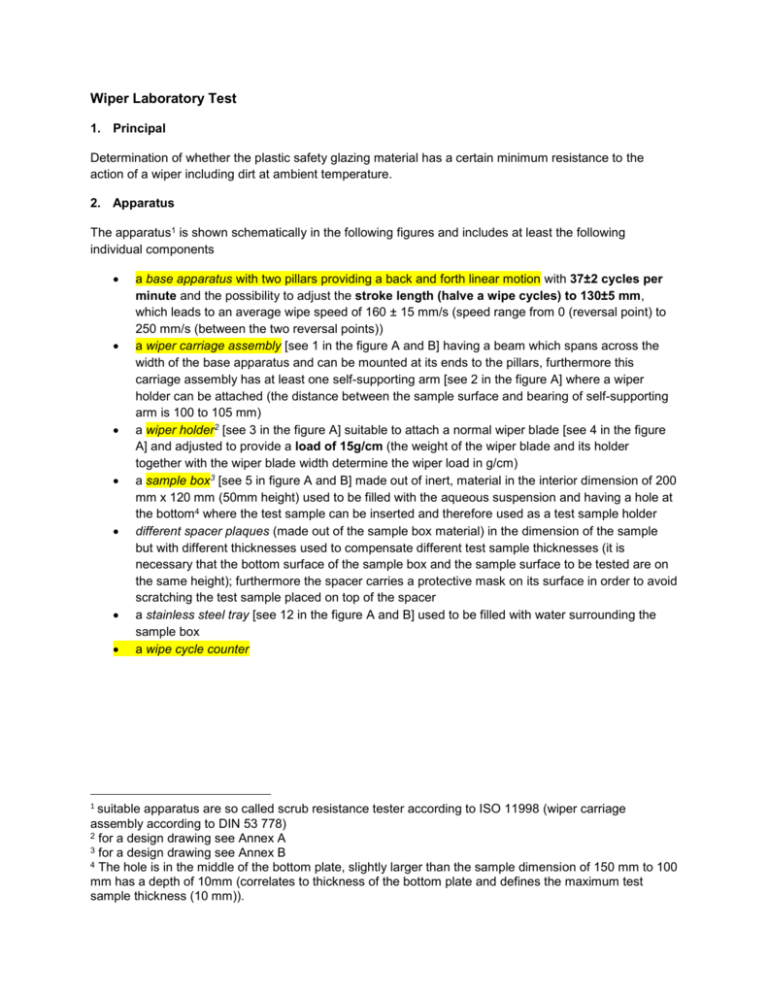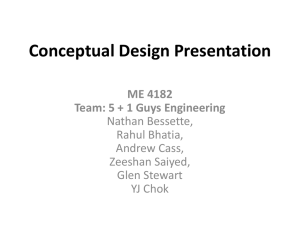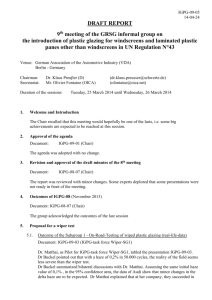IGPG-09-04e
advertisement

Wiper Laboratory Test 1. Principal Determination of whether the plastic safety glazing material has a certain minimum resistance to the action of a wiper including dirt at ambient temperature. 2. Apparatus The apparatus1 is shown schematically in the following figures and includes at least the following individual components 1 a base apparatus with two pillars providing a back and forth linear motion with 37±2 cycles per minute and the possibility to adjust the stroke length (halve a wipe cycles) to 130±5 mm, which leads to an average wipe speed of 160 ± 15 mm/s (speed range from 0 (reversal point) to 250 mm/s (between the two reversal points)) a wiper carriage assembly [see 1 in the figure A and B] having a beam which spans across the width of the base apparatus and can be mounted at its ends to the pillars, furthermore this carriage assembly has at least one self-supporting arm [see 2 in the figure A] where a wiper holder can be attached (the distance between the sample surface and bearing of self-supporting arm is 100 to 105 mm) a wiper holder2 [see 3 in the figure A] suitable to attach a normal wiper blade [see 4 in the figure A] and adjusted to provide a load of 15g/cm (the weight of the wiper blade and its holder together with the wiper blade width determine the wiper load in g/cm) a sample box3 [see 5 in figure A and B] made out of inert, material in the interior dimension of 200 mm x 120 mm (50mm height) used to be filled with the aqueous suspension and having a hole at the bottom4 where the test sample can be inserted and therefore used as a test sample holder different spacer plaques (made out of the sample box material) in the dimension of the sample but with different thicknesses used to compensate different test sample thicknesses (it is necessary that the bottom surface of the sample box and the sample surface to be tested are on the same height); furthermore the spacer carries a protective mask on its surface in order to avoid scratching the test sample placed on top of the spacer a stainless steel tray [see 12 in the figure A and B] used to be filled with water surrounding the sample box a wipe cycle counter suitable apparatus are so called scrub resistance tester according to ISO 11998 (wiper carriage assembly according to DIN 53 778) 2 for a design drawing see Annex A 3 for a design drawing see Annex B 4 The hole is in the middle of the bottom plate, slightly larger than the sample dimension of 150 mm to 100 mm has a depth of 10mm (correlates to thickness of the bottom plate and defines the maximum test sample thickness (10 mm)). Key 1 2 3 4 5 6 7 8 9 10 11 12 wiper carriage assembly moving back and forth self-supporting arm wiper blade holder wiper blade sample box working as test sample holder and as container for the aqueous suspension test sample spacer plaque (with a soft masking film on the surface to avoid scratching the sample placed on top of it) to adjust height of the sample to the level of the bottom surface of the sample box adhesive tape to fix sample and to seal the gap between sample and its box aqueous suspension filled into the box adhesive aluminium tape to fix the sample box onto the stainless steel tray water filled into the stainless steel tray (avoids penetration of aqueous suspension underneath the test sample) stainless steel tray Figure A: cross-section view of the apparatus Figure B: bird´s-eye view of the apparatus 3. Wiper blade Commercially available windscreen wiper blades based on chloroprene type rubber (CR grade) are used having a cross profile as shown in figure C 5 in a width of 80 mm. A new blade is used for every test sample and additionally if the test cycle number exceeds 10.000 wipe cycles the blade is exchanged every 10.000 wipe cycles. 5 e.g. a suitable wiper blade is Bosch “H-Stoff P6.3” Key 1 2 3 4 5 6 wiper blade lip (5 mm long) wiper blade hinge wiper blade heel (5 mm long and used to fix the wiper blade to the wiper blade holder) total length of the wiper blade 11 mm total width of the wiper blade 9 mm groove used to fix the wiper blade to the wiper blade holder (parts below the arrow are outside the wiper blade holder and parts above are within the guide rail of the wiper blade holder) Figure C: cross profile of the chloroprene type rubber blade 4. Sample The size of the flat test samples are 150 mm x 100 mm (slightly larger than the wipe area of 130mm stroke length and 80 mm wiper blade length). The thickness of the test sample corresponds to the thickness of the plastic glazing part. 5. Aqueous suspension The aqueous suspension contains 195 ±1g water (with a hardness of less than 205 mg/l after evaporation) (97,5 wt.-%) 5±0,2g so called ISO test dust A4 (according to ISO 12103-1) (2,5 wt.-%) and is freshly prepared at room temperature and stirred before use. This amount of aqueous suspension is sufficient for testing one sample for a maximum of 10.000 wipe cycles and leads to a filling level of around 10mm in the sample box. A new aqueous suspension is used for every test and additionally if the test cycle number exceeds 10.000 wipe cycles the aqueous suspension is exchanged every 10.000 wipe cycles. 6. Procedure 6.1 Sample pre-treatment Before testing the samples are cleaned using a soft cloth soaked with iso-propanol followed by deionized water and drying. After cleaning the samples are conditioned for at least 24h at 23°C ± 2°C and (50 ± 5)% relative humidity. The initial haze value according to ECE R43 of the test sample is measured at 9 measurement points across the sample [see 4 in figure F]. 6.2 Test equipment pre-check Before the equipment is used for testing samples the back and forth linear motion of the pillars of the base apparatus is checked for being uniform without any disturbance like getting stuck or starting to vibrate. Build up the whole instrument including tray, wiper carriage assembly, wiper blade holder and wiper blade but without sample box and sample (see Figure D) and align using a spirit level the base plate where later the sample box will be placed and the wiper carriage assembly. Check that the distances of the two bearings of the cantilever arm at the wiper carriage assembly and at the wiper blade holder are identical. Furthermore control visually that the wiper blade rest on the base plate uniformly without losing contact to the base plate at any point of the wiper blade. Figure D: equipment pre-check BILD 6.3 Abrasion procedure The sample box is placed into the stainless steel tray and fixed using adhesive aluminium tape on the two short sides of the box according to figure B. It is essential that the position of the box leads to a wiping area in exactly the middle of the sample [see 2 in figure F]. A spacer plaque adjusted to the thickness of the test sample so that the test sample surface and the bottom surface of the sample box are on the same height (no visible gap in height between sample and bottom surface of the sample box) is placed into the hole in the bottom of the sample box. The sample is placed with the to be tested side facing up (representing the outside surface of the plastic glazing part) into the sample holder of the sample box onto the right spacer plaque (which has a soft masking film on its surface to avoid scratching the test samples backside). An adhesive tape is used all around the test sample to fix it into the holder and seal the space between sample edge and sample box (to avoid suspension penetrating underneath the sample).The tape is used in such a way that the overlay between tape and sample is at maximum 10 mm or in other words in such a way that the wiping area of the sample [see figure F] is free of any adhesive tape. After fixing the sample a new wiper blade is mounted to the wiper blade holder and the latter one fixed to the carriage assembly. The carriage assembly is mounted to the pillars of the base apparatus thereby the wiper blade gets into contact with the sample. The correct load (15g/cm) of the wiper blade onto the sample is check using a spring balance 6. Ensure again that the whole equipment (especially test sample, box, and carriage assembly incl. wiper holder and blade) is aligned by using a spirit level. A freshly prepared suspension is filled into the sample box, while water is filled into the tray until it reaches the same level of height than the aqueous suspension in the sample box , and then the linear back and forth motion of the wiper blade is started. 6 Spring balance force: 1177 mN since the wiper blade is 80 mm long; the weight of the wiper blade holder including wiper blade and contributions of the cantilever arm (only ideally weightless) is 120g In order to ensure a homogenous abrading it is necessary to stop the test periodically and take action as described below to keep conditions constant over longer test times: every 5.000 cycles7 the test is stopped and the wiper carriage assembly is turned around (180° rotation around the vertical axes [see figure E]8; in case of a double testing apparatus (where the carriage assembly has two self-supporting arms) this leads to an exchange for the two simultaneously tested samples regarding their wiper blades 9 Figure E: rearrangement of the wiper carriage system or the sample boxes (in case of a testing equipment suitable to test two samples simultaneously) 7 and additionally every 10.000 cycles the suspension is drained, the sample removed, cleaned and assessed (visually and by measurement) according to the below procedure; after cleaning the In case the wipe cycle number to be tested is below 10.000 it is necessary to turn the wiper carriage assembly after half of the test cycles 8 Furthermore it is advisable to check if it is necessary to clean the wiper carriage assembly at that stage by disassembling and rinsing with water 9 In case of an equipment for two simultaneously tested samples - alternatively to the wiper carriage assembly turning - the two sample boxes can be exchanged without turning them whole equipment the testing of the sample can be continued using the above mentioned procedure with a new wiper blade, a new aqueous suspension and - compared to the last 5.000 wipe cycles - a turned wiper carriage 6.4 Sample treatment after abrasion When the abrasion test is finished (or an intermediate cycle number of interest is reached) the abraded test samples are cleaned using a multistep process including i. washing with running water, ii. drying, iii. wiping with an iso-propanol soaked soft cloth, iv. followed by deionized water and v. drying. After cleaning the abraded test samples are checked for visible chatter marks as this indicates a none uniform movement of the wiper during the abrasion test. In case of visible chatter marks the samples are discarded from further investigation and a retest with a new test samples needs to be done. The final haze value according to ECE R43 of the test samples is measured within the middle of the samples (area of 75 mm x 60 mm). The area at the edges of the sample - 20 mm from the long edges and 37,5 mm from the short edges - is excluded from the optical measurement. These areas include the reversal point of the wiper blade and the two ends of the wiper blade, where localized different abrasion conditions could exist compared to the middle of the test sample. 9 measurement points according to the figure below are used to determine the delta haze at these points and calculate an average delta haze afterwards. Key 1 2 3 4 sample (150 mm x100 mm) wiping area on the sample (130 mm x 80 mm) measurement area on the sample (75 x 60 mm) locations of the 9 reading areas of the haze measurement (including coordinates of the centre of the area) Figure F: measurement points across the sample 7. Expression of results Subtract the initial haze from the final haze for every measurement point, the difference representing the so-called delta haze. Calculate out of these values for the individual measurement points the average delta haze (including standard deviation) resulting from abrasion action of aqueous dirt wiped for a to be reported number of cycles on the sample surface by a wiper blade. Annex A Design Drawing of the Wiper Blade Holder view A Figure A-1: cross-cut view of the wiper blade holder with the support plate (left side) and the clamping plate (right side) view from direction A Figure A-2: side view of the support plate (left side) and the clamping plate (right side) area A Figure A-3: details regarding the area A in figure A-2 Figure A-4: 3-D view of the wiper blade holder (after inserting the wiper blade into the support plate, the clamping plate is attached and fixed using three screws) Annex B Design Drawing from the Sample Box Figure B-1: bird´s-eye view of the box (dimensions are in mm) Figure B-2: cross cut view at A Figure B-3: 3-D view of the box





